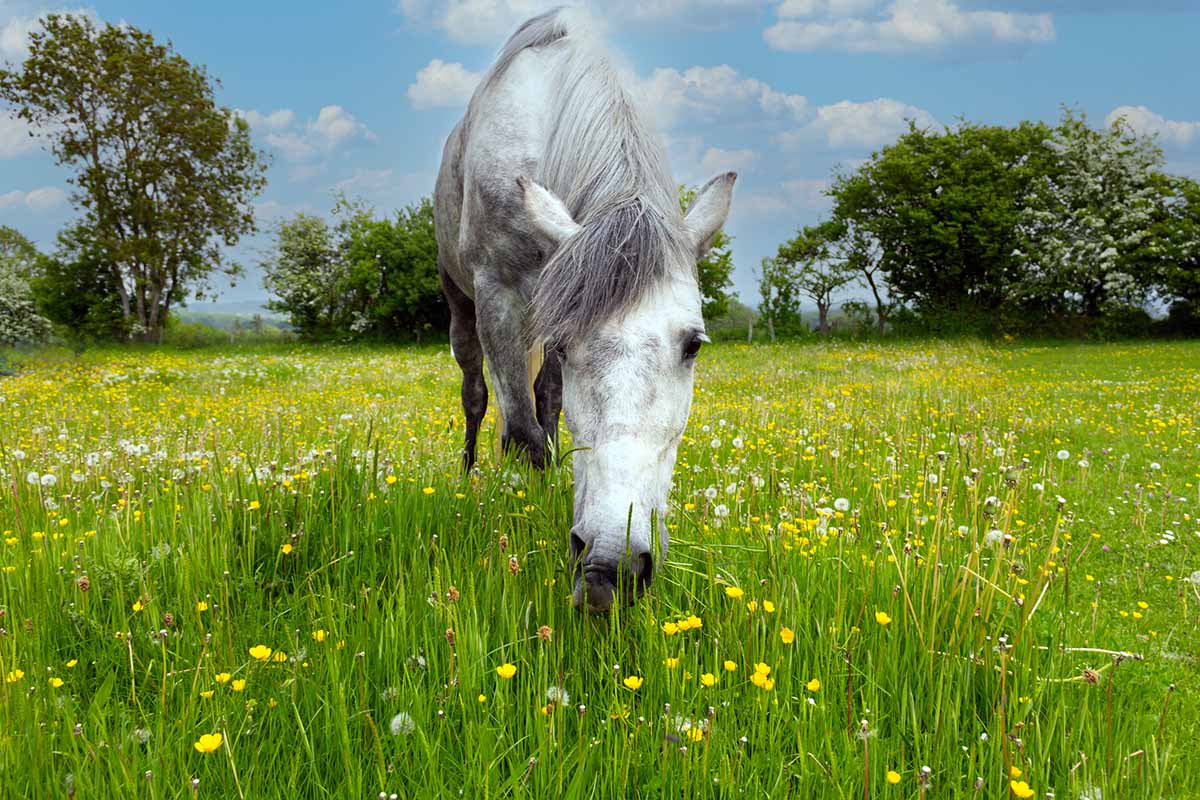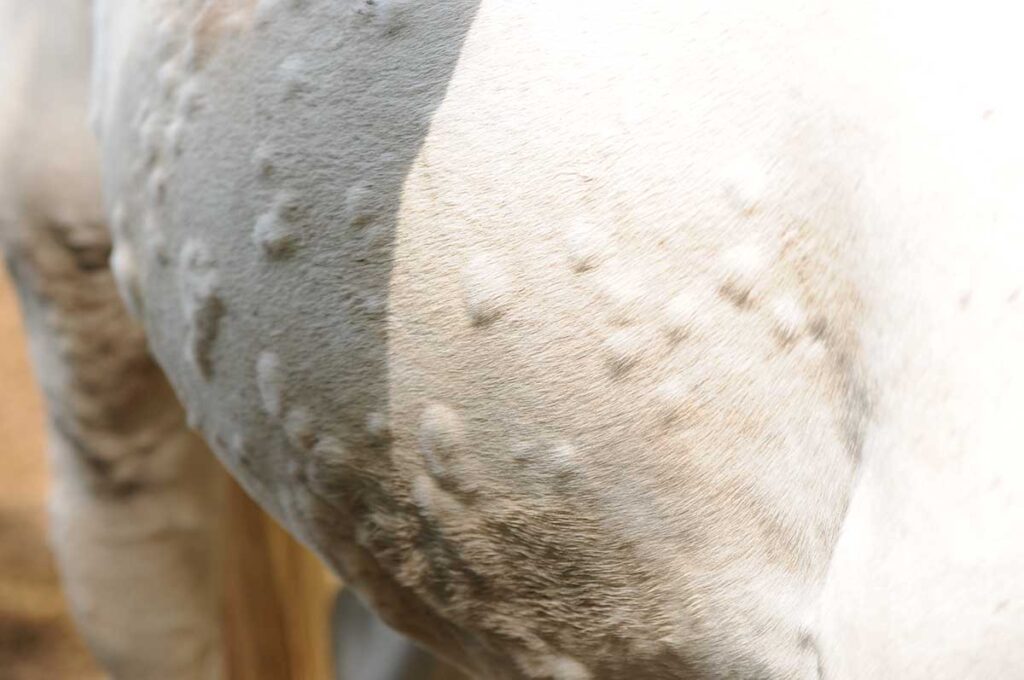Stroll through any pasture, and there among the grasses you’ll find a number of plants. Small vines, broad-leafed weeds, some wildflowers you recognize—some you don’t. And, as disquieting as it may be to contemplate, chances are pretty good that at least some plants are toxic to horses. Hundreds of poisonous plants grow in North America, and many are extremely common.
The good news, of course, is many plants toxic to horses pose little real threat. For one thing, most of them are unpalatable. Horses filling up on quality forage aren’t likely to spend time grazing on the few bitter leaves populating their pasture. Another factor that protects horses is their size. A 1,000-pound animal must consume significant quantities of a plant toxic to horses to feel any effects. So, if your horses are healthy and your pasture is in good shape, you have little to worry about.
However, some plants are cause for concern either because even a curious nibble can spell doom or because repeated browsing over weeks or months can lead to serious illness. All are worth getting to know by sight—not only so you can eliminate them from your horse-keeping areas, but also so you can avoid encounters with them in the woods, on the roadsides, and along the waterways where you ride. According to Anthony Knight, BVSc, MRCVS, retired plant toxicologist and professor emeritus from Colorado State University, these are the most dangerous 10 plants toxic to horses in the United States.
Bracken Fern (Pteridum aquilinum)
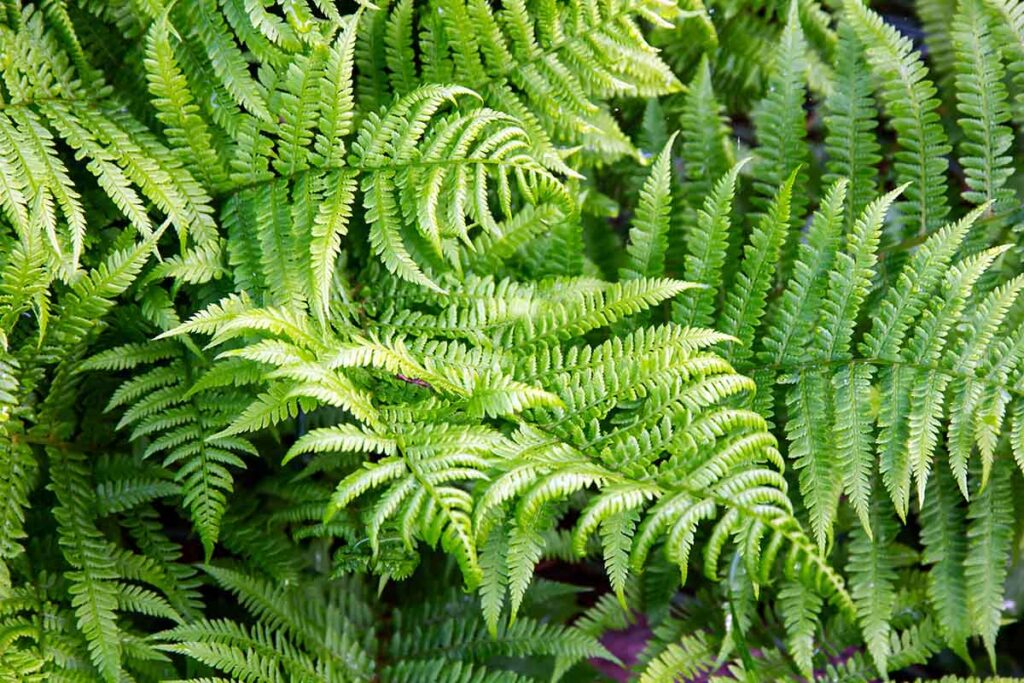
Also known as: brake fern, eagle fern
Looks like: A perennial fern with triangular leaves that can reach 2-3 feet high. Grows in clumps in woodlands and moist open areas.
Range: Coast to coast, except for the Mediterranean and desert climates of Southern California and the Southwest.
The danger: Bracken fern contains thiaminase, which inhibits absorption of thiamin, which is vitamin B1. Thiamin is necessary for nerve function, and deficiencies can lead to neurologic impairment. The relative toxicity of individual leaves is low—horses must consume hundreds of pounds to experience ill effects. However, bracken fern is unique among the plants toxic to horses in that some horses seem to develop a taste for it. They will seek it out even when other forages are available.
Signs: Signs are related to neural dysfunctions resulting from vitamin B1 deficiency and can include depression, incoordination, and blindness.
What to do: Large doses of thiamin over the course of a week or two can aid in the recovery of horses whose bracken consumption is discovered before the neurologic signs are severe.
Hemlock (Conium maculatum)
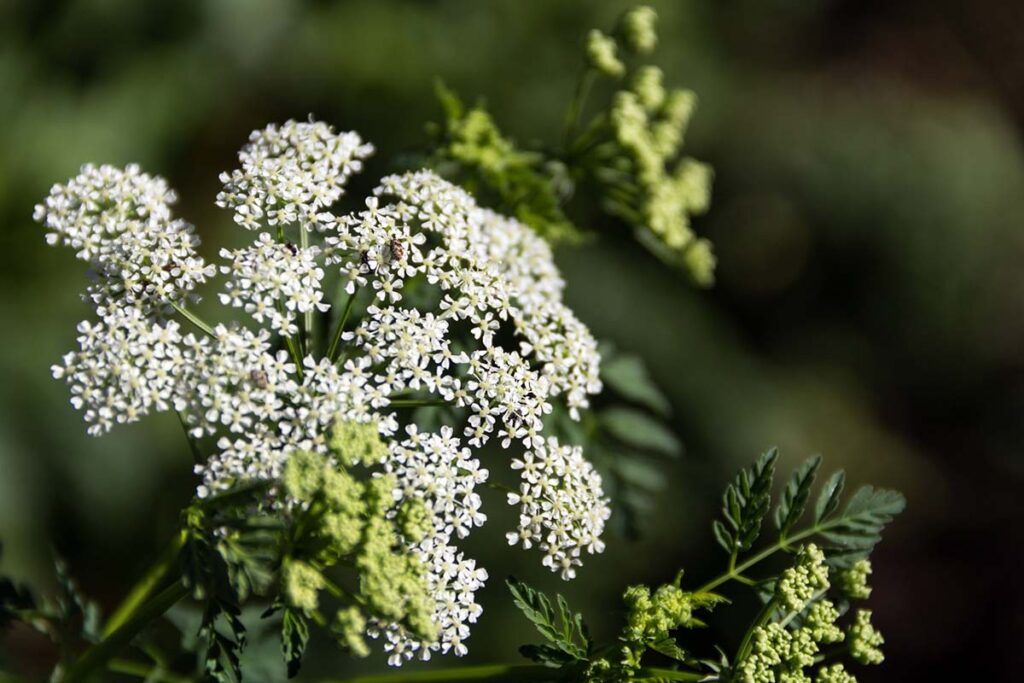
Also known as: poison hemlock, spotted hemlock
Looks like: A multistemmed perennial weed with toothed, fernlike leaves and clusters of small white flowers. The stems have purple spots, which are most evident near the base of the plant.
Range: Grows wild along roadsides and other open uncultivated areas throughout North America.
The danger: Hemlock leaves, stems, and seeds contain several potent neurotoxins that affect both the central and peripheral nervous systems. Four to five pounds is a lethal dose for a horse. Most animals will avoid the plant.
Signs: Signs appear within an hour or two of consumption, starting with nervousness, tremors, and incoordination, progressing to depression and diminished heart and respiratory rates and possibly colic. Death results from respiratory failure.
What to do: There is no treatment, but if smaller doses were consumed, animals may recover with supportive care.
Tansy Ragwort (Senecio spp.)

Also known as: groundsel
Looks like: A multistemmed weed with alternating leaves that produces clusters of small daisylike yellow flowers.
Range: About 70 species of senecio grow throughout the contiguous United States, in many habitats. Many are common in pastures and along roadsides.
The danger: Levels of toxicity vary among different members of the species, but all are thought to contain at least some concentration of pyrrolizidine alkaloids, which inhibit cell division, especially in the liver. Damage to the liver is cumulative and irreversible. Most horses succumb to chronic exposure over time, after consuming between 50 and 150 pounds total of these plants toxic to horses.
Signs: Often, there is no evidence of consumption until signs of liver failure begin to appear. These include photosensitization, diminished appetite, and weight loss, progressing to depression, incoordination, and jaundice.
What to do: There is no treatment for advanced stages of liver disease due to this toxin.
Johnsongrass/Sudan Grass (Sorghum spp.)
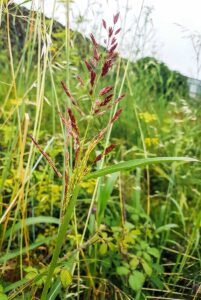
Looks like: Both johnsongrass and Sudan grass are coarse-stemmed grasses with broad, veined leaves that can grow to 6 feet in height. Both produce large, multibranched seed heads.
Range: Johnsongrass is a wild grass native to the southern climates, where it grows along roadways and other uncultivated open areas. A close relative, Sudan grass and its hybrids are cultivated throughout the United States as a forage crop.
The danger: The leaves and stems of johnsongrass and Sudan grass contain a cyanide compound, which when metabolized inhibits the body’s ability to absorb oxygen, in effect suffocating the animal. Young shoots of johnsongrass contain the highest concentration of the toxin. Because horses do not metabolize the cyanide compound as efficiently as ruminant animals do, grazing healthy adult plants is unlikely to harm them. Circumstances that injure the plant—wilting, trampling, frost—can chemically liberate the cyanide within the leaves, rendering them dangerous to all species. Cultivated hybrids of Sudan grass typically contain less cyanide, if any. Both species can also accumulate toxic levels of nitrates if overfertilized. Cyanide concentration drops to safe levels when the grasses are cured for hay, but nitrates, if present, do not.
Signs: Signs are consistent with cyanide poisoning. The first indication is rapid breathing, which progresses to tremors, frequent urination and defecation, gasping, and convulsions.
What to do: Supportive drug therapy can offset the effects of less severe cyanide poisoning from this plant toxic to horses.
Locoweed (Astragalus spp. or Oxytropis spp.)
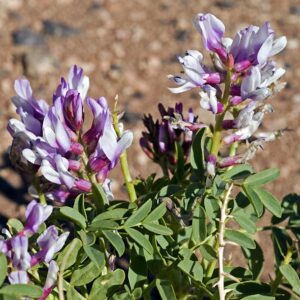
Also known as: Crazy weed
Looks like: Leafy perennials with short stems and compound leaves that grow in tuftlike forms from a single taproot. Some species may be covered with silvery hairs. The flowers, often white or purple, are borne on leafless stalks.
Range: Different species of locoweed—spotted or blue, wooly, purple, Lambert’s, two-grooved milk vetch, white-point—grow in varied terrains throughout the West and Southwest, often in dry, sandy soil.
The danger: All toxic species of locoweed contain swainsonine, an alkaloid that inhibits the production of the enzyme necessary for saccharide metabolism. The resulting sugar buildup disrupts the function of brain cells.
Signs: Strange behavior is usually the first evidence. Horses might bob their heads, adopt exaggerated, high-stepping gaits, or stagger and fall.
What to do: There is no treatment for advanced locoism, and its effects are irreversible. Horses with less severe poisoning might recover when access to the weed is removed.
Oleander (Nerium oleander)
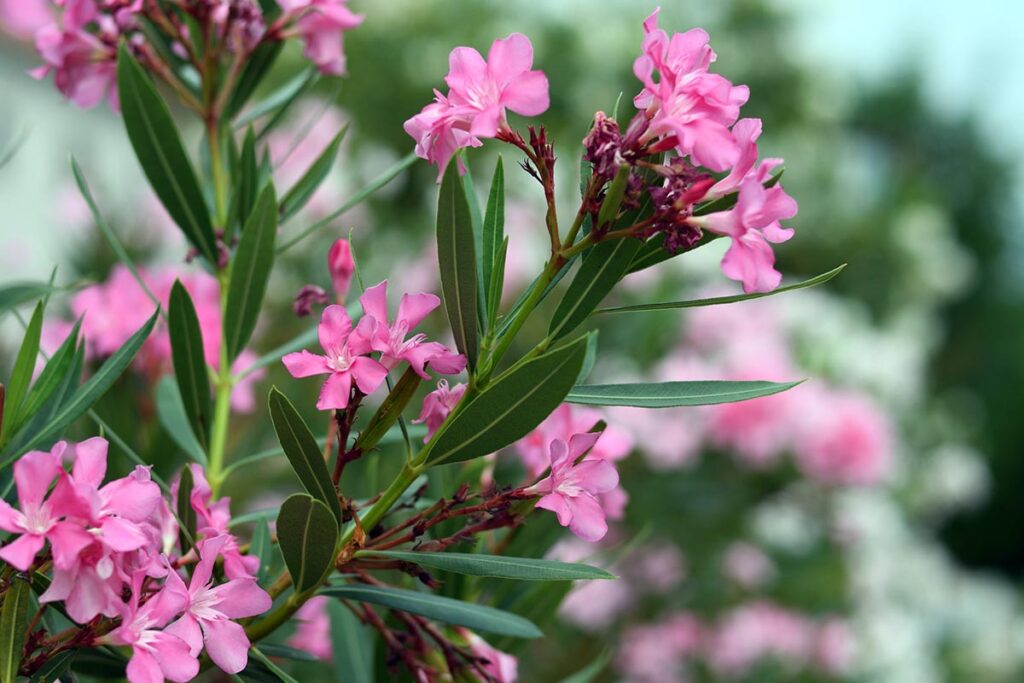
Also known as: Rose laurel, adelfa, rosenlorbeer
Looks like: An evergreen shrub that can reach the size of a small tree, oleander has elongated, thick leathery leaves that can grow to 3 to 10 inches long. The flowers, which grow in large clusters at the end of branches, are 1-3 inches in diameter and can be white, pink, or red.
Range: Hardy only in hot climates, oleander is used extensively in landscaping across the southern United States, from California to Florida. It is also grown as a potted plant in northern areas.
The danger: All parts of the plant contain the toxins oleandrin and neriin, which disrupt the beating of the heart. The leaves remain toxic when dried. About 30 to 40 leaves can be deadly to a horse.
Signs: Effects are usually seen several hours after ingestion and last over 24 hours. Signs include colic, difficulty breathing, tremors, recumbency, and an irregular heart rate. The pulse might be either slowed or accelerated.
What to do: Horses can survive if treated early with supportive care, such as the administration of activated charcoal to inhibit further toxin absorption and the use of anti-arrhythmic drugs to stabilize the heart.
Red Maple Trees (Acer rubrum)
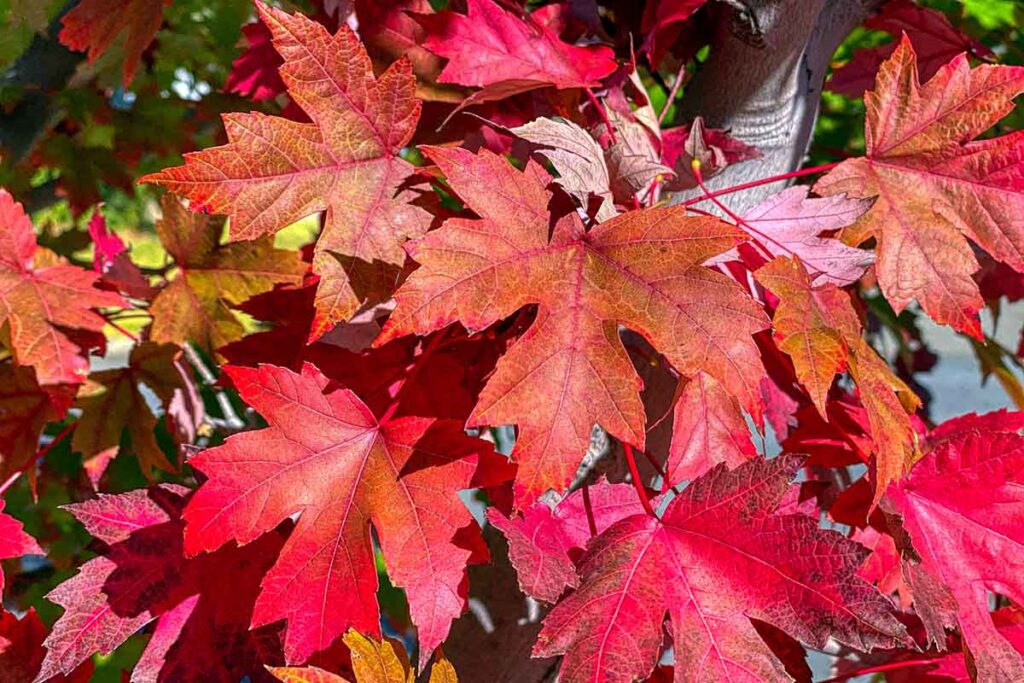
Looks like: A medium-sized tree with leaves that are green in the spring and summer, with shallow notches, bright red stems, and a whitish underside. In fall, the leaves turn bright red. The bark is smooth and pale gray on young trees and becomes dark and broken on older trees.
Range: The native range is eastern North America, from Canada to Florida and west to Minnesota and eastern Texas. Ornamental specimens have been planted all over the country.
The danger: Ingestion of fresh, growing red maple leaves seems to do little or no harm. When the leaves wilt, however, they become extremely toxic to horses. Access to wilted leaves is most common after storms, which might cause branches to fall into pastures, or in the autumn when the leaves fall and are blown into grazing areas. The toxins in wilted red maple leaves cause the red blood cells to break down so the blood can no longer carry oxygen. The kidneys, liver, and other organs might also be damaged. As little as a pound or two of leaves can be fatal.
Signs: Depending on how many leaves a horse ate, signs can appear within a few hours or as long as four or five days after consumption. Signs include lethargy; refusal to eat; dark red-brown or black urine; pale yellowish gums and mucous membranes at first, advancing to dark muddy brown; increased respiratory rate; rapid heart rate; dehydration.
What to do: The only treatment is the administration of large amounts of intravenous fluids and possibly blood transfusions. Recovery depends on how many leaves a horse consumes and how promptly he receives care.
Special note: Research indicates the leaves of at least two related species—the silver and sugar maples—might contain the same toxic elements as red maples but in less harmful amounts.
Water Hemlock (Cicuta spp.)
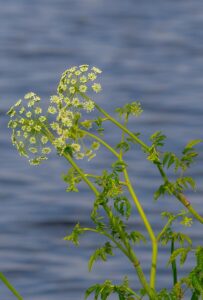
Also known as: Spotted water hemlock
Looks like: A perennial weed with erect hairless stems that can grow to 6 feet from clusters of fleshy roots. The stems are hollow and branching, thicker at the base. Leaves are elongated and toothed, and the small white flowers form flat, umbrella-shaped clusters at the ends of branches.
Range: Water hemlock grows throughout the contiguous United States. It’s most likely to grow in marshy areas of meadows and along streams and irrigation ditches.
The danger: Water hemlock is one of the most toxic plants in the United States. All parts of the plant contain a cicutoxin alkaloid that affects the central nervous system, but the toxin is most concentrated in the root. Because cattle are more likely to pull up and consume the root, that species is most at risk of poisoning, but horses have also been known to browse the plant; less than a pound of the leaves and stems can be fatal. The toxin levels in the leaves and stems diminish as the plant ages during the growing season, and additional amounts of toxin are lost when the plant is dried, but water hemlock is never considered safe for consumption. Most animals will avoid the plant.
Signs: The toxins affect neurons primarily within the brain, causing various signs, including excessive salivation, dilated pupils, and nervousness, progressing rapidly to difficult breathing, degeneration of the heart and skeletal muscles, seizures, and convulsions. Death usually results from respiratory paralysis. Signs of poisoning appear within an hour of ingestion, and death typically follows within two to three hours.
What to do: Supportive care initiated before the convulsions begin can offset the worst effects of the seizures. Horses that survive are likely to have experienced permanent damage to the heart and skeletal muscles.
Yellow Star Thistle/Russian Knapweed (Centauria spp.)
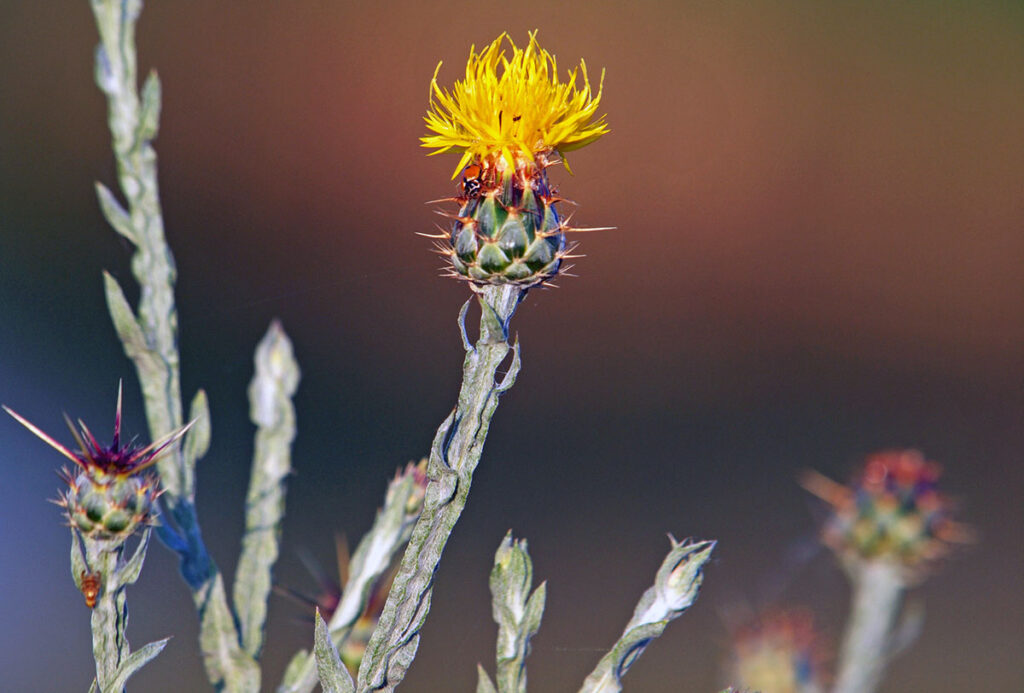
Also known as: Barnaby’s thistle
Looks like: Yellow star thistle is an annual weed that branches out from a single base stem to form a spherical plant up to 3 feet tall. Stiff spines 1/2 to 3/4 of an inch long surround its round yellow flowers. Russian knapweed spreads via a creeping root system. Its erect, stiff stems grow 2-3 feet high and are covered with gray hairs. Its thistlelike flowers range from purple to white; Russian knapweed has no spines or prickles.
Range: Both of these plants toxic to horses grow throughout the Western United States, approximately from Missouri to California, and from Mexico northward, almost to Canada. They appear as weeds along roadsides and in cultivated fields and pastures.
The danger: Both of these plants toxic to horses contain an agent that has a neurologic effect on the brain that inhibits the nerves and controls chewing. The poisoning is chronic in nature; to receive a toxic dose, horses must consume 50-200% of their body weight over 30 to 90 days.
Signs: Affected horses might appear to have tense or clenched facial muscles, and they are unable to bite or chew their food effectively. Weight loss is also common.
What to do: There is no treatment, and any neural damage is permanent. Horses too debilitated to eat might require euthanasia.
Yew (Taxus spp.)
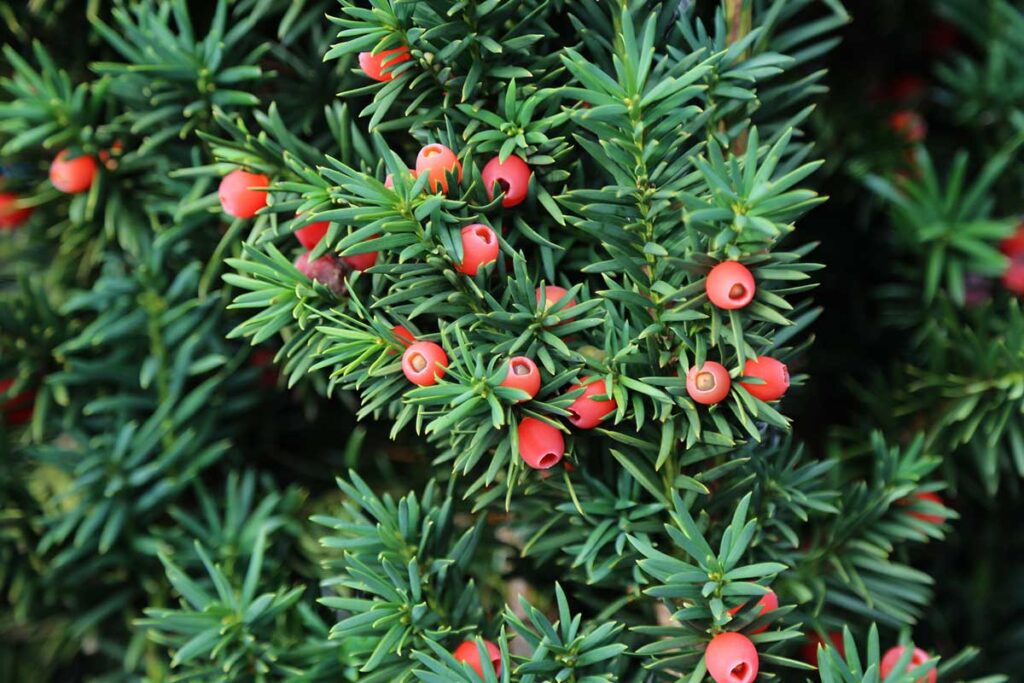
Looks like: A woody evergreen shrub with closely spaced, flat, needlelike leaves a half-inch to one inch long. Berries are bright red or yellow, soft, and juicy with a hole in the end, where the dark seed is visible.
Range: Western yew and American yew are native to the West Coast and the Eastern and Central United States, respectively. However, these two species, along with the Japanese and English yews, are commonly planted as ornamentals nationwide.
The danger: All parts of this plant toxic to horses, except for the fleshy portion of the berries, contain taxine, an alkaloid that causes respiratory and cardiac collapse. The leaves remain toxic even after dried. A single mouthful can be deadly to a horse within minutes.
Signs: Sudden death is the most typical sign of yew ingestion. Animals found alive might be trembling and colicky, with difficulty breathing and a slowed heart rate.
What to do: There is no treatment for yew poisoning, making avoidance critical. Most yew poisonings occur when trimmings are thrown into a pasture after pruning.
Take-Home Message
Familiarize yourself with these plants toxic to horses, and call your veterinarian at the first sign your horse might have ingested something poisonous. The faster you can intervene, the better his chances of recovery. Also avoid planting poisonous ornamentals around the barn, and practice good weed control in your pastures.
Related Reading: How To Take Horse Vital Signs and What They Mean
This article originally ran in EQUUS magazine.
Are you enjoying this content? Sign up for My New Horse’s FREE newsletter to get the latest horse owner info and fun facts delivered straight to your inbox!

